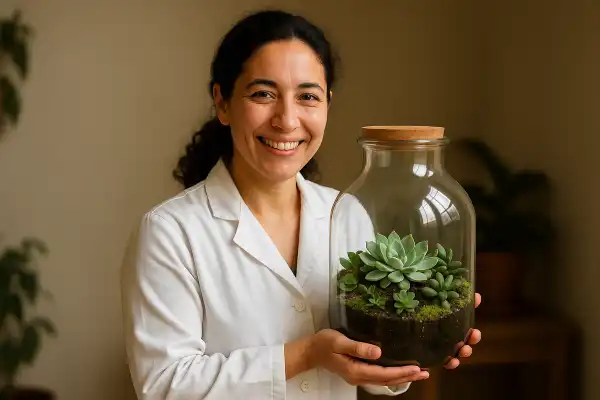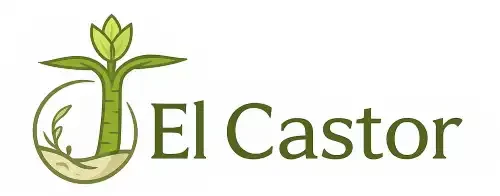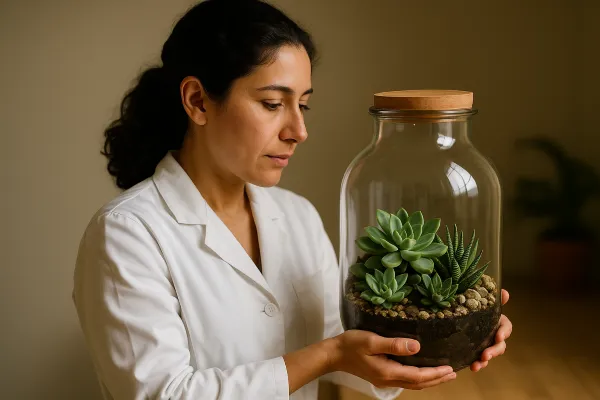How to make a succulent terrarium has become one of the most searched plant care questions as people discover the joy of creating miniature desert worlds. The appeal lies in their simplicity—these contained ecosystems require minimal maintenance while delivering maximum visual impact.
Many enthusiasts gravitate toward succulent terrariums after struggling with traditional houseplants. The controlled environment allows even beginners to cultivate thriving micro-gardens that showcase the architectural beauty of desert plants in glass vessels.
How to make a succulent terrarium?
Making a succulent terrarium involves creating an open glass container garden with proper drainage layers, specialized soil, and carefully selected plants that thrive in low-humidity environments. Unlike traditional closed terrariums, succulent terrariums must remain open to provide essential airflow and prevent the high moisture conditions that would quickly kill these arid-adapted plants.
The process requires understanding succulent biology—these plants store water in their thick, fleshy tissues and have evolved sophisticated drought-survival mechanisms. Creating the right growing medium mimics their natural sandy, gravelly habitats where soil drains rapidly after rainfall. This foundation knowledge ensures your terrarium becomes a thriving ecosystem rather than a decorative disappointment.

Selecting the perfect container
Glass terrariums with open tops are ideal for succulents, allowing for airflow and mimicking the dry, sunny environment succulents love. The container should have several key characteristics: a wide opening for easy planting and maintenance, clear glass walls for optimal light penetration, and sufficient depth to accommodate both drainage layers and root systems.
The container should be at least 2-3 inches deep so that the roots of your succulents have enough room to spread out, with an opening wide enough for you to easily fit your hands and tools inside when planting. Popular choices include glass bowls, fishbowls, apothecary jars, and geometric glass vessels. Avoid containers with narrow necks or those designed for closed terrarium systems.
The size directly impacts your plant selection and long-term success. Larger containers create more stable environments and allow for diverse plant arrangements, while smaller vessels work well for single-specimen displays or propagation projects.
Building the foundation layers
Place a layer of small pebbles or rocks at the base of the container—this layer acts as a drainage system, preventing excess water from accumulating and safeguarding the succulents from potential root rot. This drainage layer should measure approximately one to two inches deep, using materials like aquarium gravel, small river rocks, or horticultural pebbles.
Place a thin layer of activated charcoal over the rocks—this addition serves as a natural filter, absorbing excess moisture, preventing mold growth, and ensuring a fresh and odor-free environment within the terrarium. However, some experts recommend skipping activated charcoal for succulent terrariums since succulents don’t require the odor control that charcoal provides, and it can retain too much moisture, potentially causing root rot.
For an additional barrier, many terrarium builders add a thin layer of sphagnum moss between the drainage layer and soil. The moss is beneficial for absorbing water and maintaining the plants’ moisture levels while creating a barrier to prevent soil from seeping into the drainage layer.
Choosing the right soil mixture
Soil designed for succulents, often labeled “cactus soil” or something similar, is ideal since regular potting soil tends to hold onto moisture, which can be harmful to succulents. Look for a gritty mixture that prioritizes drainage—a blend of coco coir fiber, horticultural sand, pumice, activated charcoal, and a small amount of worm castings creates the ideal growing medium.
Commercial succulent mixes work well, though you may want to mix your cactus soil with perlite so that it retains even less moisture in the closed terrarium environment. The perfect succulent soil needs to drain quickly while still providing nutrients, with most succulents preferring slightly acidic to neutral soil with a pH between 6.0 and 7.0.
The soil layer should be thick enough to support root development—typically 2-3 inches depending on your container size and plant selection. Gently compress your substrate layer once placed inside your terrarium and lightly mist to make it more malleable for planting.
Plant selection strategies
Choose slow-growing succulents to prevent overcrowding in your terrarium, prioritizing varieties that flourish in bright, indirect light. Excellent choices include Haworthia species with their interesting textures and patterns, Echeveria with rosettes of plump, spoon-shaped leaves in various colors, Jade plants for their classic appeal, and Bear Paw succulents for their whimsical fuzzy leaves.
Choose a selection of succulent plants with different colors, forms, and textures to enhance the visual appeal and provide a miniaturized representation of the succulent world. Consider growth habits when arranging—place taller, architectural plants toward the back or center, with spreading or trailing varieties around the edges.
Avoid cacti, as the terrarium environment isn’t a great match for them due to their specific light and humidity requirements. Stick to true succulents that adapt better to container culture and lower light conditions.
Assembly and planting techniques
Plan ahead and strategize how to place each plant in the container so they’re grouped in a visually pleasing and space-efficient way, starting with the largest feature plant. Remove each plant from its nursery container and carefully remove excess dirt from around the roots, leaving them fairly bare and easier to plant.
Make a small hole in the soil using a spoon or small trowel, plant the roots carefully, and build soil back around while pressing firmly to ensure proper rooting. Space plants at least an inch apart to ensure adequate airflow, and consider using a dowel or chopstick for precise placement in tight spaces.
Some succulents come in large clusters and can be carefully broken into smaller pieces that you can space out around a larger plant. This propagation technique allows you to create fuller displays while respecting the space constraints of terrarium culture.
Care and maintenance protocols
Water your succulent terrarium very sparingly, when the soil has gone almost completely dry, using a watering can or spray bottle around the base of each plant. Most succulent terrarium owners prefer using a mist bottle or turkey baster rather than pouring water directly, as it should never be overwatered.
Give a small sampling of the leaves a gentle squeeze approximately once a week—if the leaves are firm like a plump grape there’s no need to water, but if they have some give to them, they’re ready for water. Only add more water once the soil is totally dry to the touch, watching as you add water and stopping once you see it running down to the bottom layer.
Place your succulent terrarium in the sunniest window of your house, as most succulents need full sun to thrive, which means at least six hours of direct, unfiltered light. However, avoid placing glass terrariums in direct midday sun, which can create greenhouse effects that damage plants.
Troubleshooting common problems
The most common mistake people make with succulents is overwatering—when plants get too much water, the bottom leaves die or rot, becoming squishy and gross. Signs include mushy, brown or black leaves, which means you should remove these plants and replace with comparable specimens while reducing watering frequency.
If you notice condensation building up inside your terrarium, open it briefly to allow fresh air to circulate and prevent mold growth. Too much moisture can lead to root rot that sets in suddenly and terminally—if succulent plants are rotting at the base, you may be able to take a cutting from the healthy top section and replant in a regular pot.
Light burn appears as brown or white patches on leaves. If some leaves burn, don’t worry—they will grow more leaves and the old ones will die naturally, just move your terrarium away from the too-bright area.
Conclusion
Last weekend, I created a succulent terrarium using a vintage glass bowl I discovered at a local market, carefully layering river rocks, specialized cactus soil, and arranging five different Echeveria varieties alongside a striking Haworthia. The afternoon spent crafting this miniature desert landscape reminded me why these contained ecosystems continue to captivate both beginners and experienced plant enthusiasts—they offer the perfect balance of creative expression and botanical science, requiring just enough care to keep you engaged without overwhelming your schedule.

